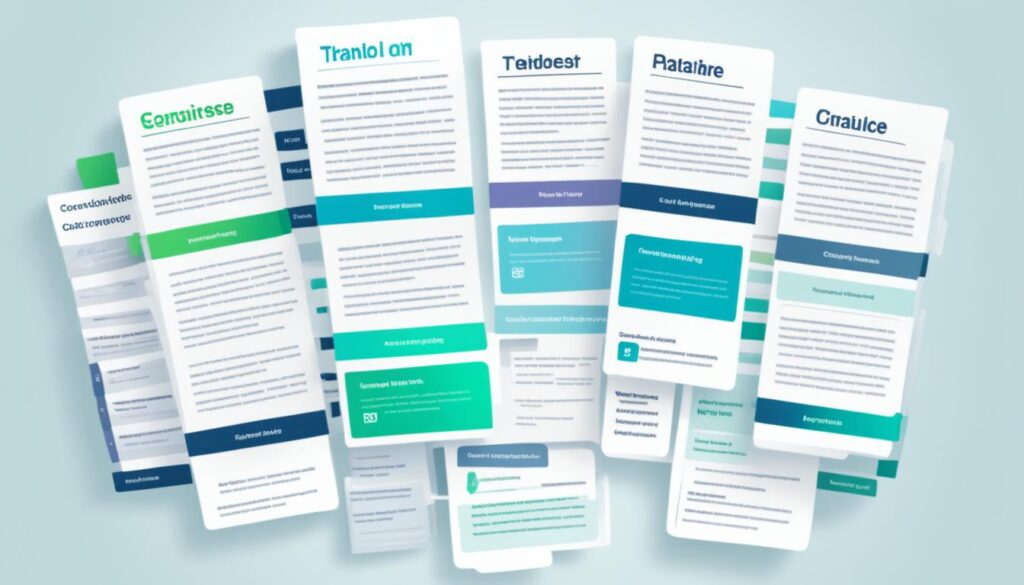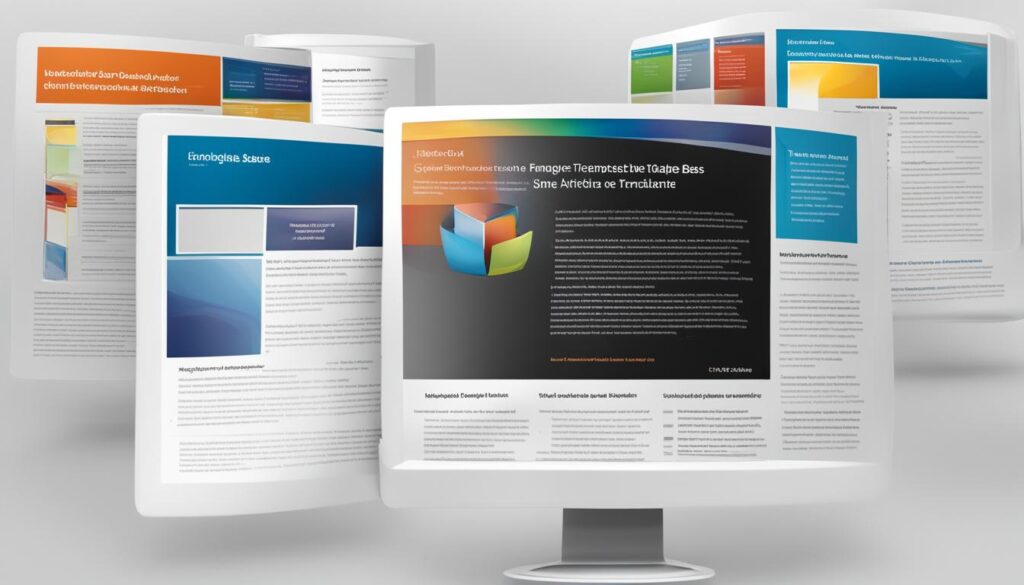A knowledge base is a valuable resource that can enhance customer support and empower users to find solutions independently. By leveraging knowledge base templates, you can streamline the creation process and design an efficient repository of information. Whether you need a template for a product knowledge base, FAQ section, or troubleshooting guide, utilizing knowledge base templates can significantly improve your support efforts.
Knowledge base templates offer a structured framework that ensures consistency in design, layout, and content organization. With customizable options, you can tailor the templates to match your brand’s aesthetics and incorporate your unique content requirements.
Design is a crucial aspect of a knowledge base as it influences user experience and accessibility. A well-designed knowledge base template makes it easier for users to navigate and locate the information they need quickly. It enhances the effectiveness of your support system, saving time for both customers and support representatives.
Importance of Knowledge Bases
Knowledge bases play a crucial role in providing efficient customer support and streamlining information sharing. Let’s explore the key reasons why knowledge bases are so important and the benefits they offer:
1. Free up support reps
By utilizing a knowledge base, businesses can empower their customers to find answers to common questions on their own. This frees up support representatives to focus on addressing more complex issues, ultimately improving the overall efficiency of the support team.
2. Provide faster solutions
Gone are the days when customers have to wait for a support representative to respond to their queries. Knowledge bases allow users to instantly access the information they need, resulting in faster problem-solving and enhanced customer satisfaction.
3. Include various types of content
Knowledge bases are not limited to just text-based articles. They can incorporate diverse content formats such as FAQs, video tutorials, and step-by-step guides. This multi-media approach makes it easier for customers to understand and utilize products and services effectively.

4. Easy to build and expand
Building a knowledge base doesn’t have to be a daunting task. Businesses can start by addressing common customer questions and gradually expand their content based on user feedback and evolving needs. This iterative approach ensures that the knowledge base remains relevant and up-to-date.
As you can see, knowledge bases offer numerous benefits and are an essential component of any customer support strategy. They empower customers, improve response times, and provide a wealth of information in various formats. Incorporating a knowledge base into your business operations can elevate your customer support to new heights.
Best Practices for Building a Knowledge Base
When it comes to building a knowledge base, there are several best practices you should follow to ensure its effectiveness. From designing a user-friendly interface to continuously updating and improving your content, here are some tips for creating a knowledge base that provides valuable information to your customers:
1. Designing a User-Friendly Interface
Your knowledge base should have a clean and intuitive interface that makes it easy for customers to navigate and find the information they need. Implement a search function that allows users to search for specific topics or issues, and organize your content into categories or top articles to provide easy access to commonly sought-after information.

2. Determining the Writing Process
When creating knowledge base articles, it’s important to establish a clear writing process. Start by giving your articles descriptive titles that accurately reflect their content. Keep the language simple and concise, making it easy for users to understand. Include helpful resources and links within your articles to provide additional information and guidance.
3. Enhancing User Experience with Visuals
Visuals play a crucial role in enhancing the user experience of your knowledge base. Consider including screenshots, videos, or infographics to visually demonstrate concepts or provide step-by-step instructions. Visuals can help users better understand the content and improve their overall experience with your knowledge base.
4. Continuously Updating and Improving
A successful knowledge base is one that is continuously updated and improved based on user feedback and data metrics. Regularly review and analyze user feedback to identify areas of improvement and address any gaps in your content. Monitor metrics such as page views and search queries to gain insights into what information your customers are seeking, and use this data to optimize your knowledge base.
| Benefits of Following Best Practices | Tips for Building a Knowledge Base |
|---|---|
| 1. Improved customer satisfaction | 1. Design a user-friendly interface |
| 2. Reduced support ticket volume | 2. Establish a clear writing process |
| 3. Faster resolutions for customers | 3. Enhance user experience with visuals |
| 4. Increased self-service success rate | 4. Continuously update and improve |
Different Types of Knowledge Base Templates
When it comes to building a knowledge base, using the right template is crucial for delivering relevant and effective content to your customers. Different types of knowledge base templates can be utilized based on the specific needs of your customer audience. To help you get started, here are some examples of knowledge base templates that you can consider:
1. FAQ Templates
FAQ templates are excellent for addressing common questions and providing concise answers. They allow customers to quickly find the information they need without the need for extensive searching or reading through lengthy articles. Using FAQ templates helps you present information in a clear and organized manner, making it easier for users to navigate and access the relevant content.
2. Product and Service Description Templates
When it comes to describing your products and services, having a well-designed template can make a significant difference. Product and service description templates enable you to provide comprehensive information about your offerings, their features, benefits, and specifications. These templates help customers understand your products and services more effectively, making it easier for them to make informed purchasing decisions.
3. Onboarding Flow Templates
For new customers, onboarding flow templates are invaluable for helping them get up to speed quickly and efficiently. With a well-structured onboarding flow, you can guide users through the essential steps and processes necessary to start using your product or service. These templates ensure a smooth onboarding experience and reduce the learning curve for new customers, improving their overall satisfaction.
4. Troubleshooting Guide Templates
Technical issues can be a source of frustration for customers, but having troubleshooting guide templates can help them navigate through these challenges effectively. These templates provide step-by-step instructions and solutions for resolving common technical issues. Troubleshooting guide templates empower customers to troubleshoot problems on their own, reducing their reliance on support teams and saving time for both parties involved.
Choosing the right type of knowledge base template depends on the specific needs of your customer audience. It’s essential to consider the nature of your products or services, the common questions or issues customers may have, and the level of guidance or instruction required. By leveraging different types of knowledge base templates, you can create a well-rounded and comprehensive knowledge base that caters to the diverse requirements of your customers.

Best Practices for Writing Effective Knowledge Base Articles
When it comes to writing knowledge base articles, there are several best practices that can help you create content that is informative, helpful, and engaging. By following these tips, you can ensure that your articles are effective in providing the information your readers need.
- Avoid making assumptions: It’s important to remember that your readers may have different levels of knowledge and understanding. Avoid using technical jargon and assume that your readers are starting from scratch. Instead, provide clear and step-by-step instructions to guide them through the process.
- Use anchor links: In lengthy articles, it can be helpful to break up the content into sections and provide anchor links so users can easily navigate to the specific information they need. This improves the user experience and saves them time.
- Make it easy to skim: Many users skim articles to find the information they’re looking for. To accommodate this reading behavior, use headings, bullet points, and visuals to make your content scannable. This allows readers to quickly identify the most relevant sections.
- Be concise: Keep your articles concise and to the point. Avoid unnecessary explanations or rambling paragraphs. Focus on delivering the information in a clear and concise manner without overwhelming your readers.
Furthermore, align your knowledge base articles with the goals of your readers. Understand what they want to achieve and craft your content accordingly. Organize your articles in a logical manner based on the customer workflow. This ensures that readers can easily find the information they need, improving their overall experience.
Additionally, strategically link your articles to related content within your knowledge base. This helps readers explore further and find additional resources that may be helpful to them. This internal linking also improves the SEO of your knowledge base by establishing connections between related articles.
Lastly, never underestimate the power of user feedback. Actively encourage your users to provide feedback on your knowledge base articles. This feedback can help you identify areas for improvement and ensure that your content remains relevant and up-to-date. Continuously make updates and improvements to your articles based on user feedback and data metrics to enhance their effectiveness.
By incorporating these best practices into your writing process, you can create knowledge base articles that are valuable, user-friendly, and provide the information your readers need to succeed.
Examples of Knowledge Base Article Templates
Knowledge base article templates are valuable resources for creating informative and user-friendly content. They assist in streamlining the knowledge base creation process, ensuring consistency and clarity in the articles. Here are some examples of knowledge base article templates:
FAQ Templates
FAQ templates are perfect for addressing frequently asked questions. They provide concise and direct answers to common inquiries, making it easy for users to find the information they need quickly.
Product and Service Description Templates
Product and service description templates enable businesses to provide comprehensive information about their offerings. These templates outline the features, benefits, and specifications of products or services, helping users make informed decisions.
Onboarding Flow Templates
Onboarding flow templates guide new customers through the process of getting started with a product or service. They break down the necessary steps and provide clear instructions, ensuring a smooth onboarding experience.
Troubleshooting Guide Templates
Troubleshooting guide templates offer step-by-step instructions to help users resolve technical issues effectively. They provide systematic approaches to identify and troubleshoot problems, ensuring a seamless user experience.
These templates can be customized based on your target audience and the specific needs of your knowledge base. By utilizing these templates, you can simplify the user experience, deliver relevant content, and continuously improve your knowledge base.
For a visual representation of these knowledge base article template examples, see the table below:
| Template Type | Description |
|---|---|
| FAQ Templates | Concise answers to frequently asked questions |
| Product and Service Description Templates | Comprehensive information about offerings |
| Onboarding Flow Templates | Guidance for new customers getting started |
| Troubleshooting Guide Templates | Step-by-step instructions to resolve technical issues |
These templates serve as a foundation for creating effective knowledge base articles, ensuring consistency, clarity, and an improved user experience.

Simplifying the User Experience with Knowledge Bases
Knowledge bases are designed to improve user experience by providing self-serve options for customers to find solutions to their problems. By offering a comprehensive collection of helpful articles, FAQs, troubleshooting guides, and product descriptions, knowledge bases empower users to find answers on their own. This not only enhances customer support but also saves time for both customers and support representatives.
The self-serve nature of knowledge bases allows customers to access the information they need at their convenience, reducing their reliance on support teams. Through knowledge bases, customers gain access to timely and accurate information, ultimately leading to enhanced customer satisfaction. With knowledge bases, users have the autonomy to resolve issues efficiently and effectively, without the need for constant assistance.
Having a knowledge base that is easily accessible and well-organized enables customers to quickly find the information they require, streamlining the support process. With a diverse range of content available at their fingertips, users can navigate through knowledge bases at their own pace, ensuring a seamless and personalized experience.
The benefits of knowledge bases extend beyond customer support. By empowering users to find answers independently, knowledge bases free up valuable resources for support representatives to focus on more complex issues. Moreover, knowledge bases help businesses deliver consistent and accurate information, fostering a strong brand reputation in the eyes of the customers.
| Benefits of Knowledge Bases |
|---|
| Improves user experience |
| Enhances customer support |
| Frees up support resources |
| Delivers consistent and accurate information |
| Strengthens brand reputation |
Knowledge bases are a valuable tool for businesses seeking to optimize their customer support and enhance user experiences. By providing self-serve options and a wealth of information, knowledge bases empower customers to find solutions on their own terms, while freeing up support resources and contributing to a positive brand reputation.
Continuous Improvement of Knowledge Base Articles
To ensure that your knowledge base remains valuable and effective, it is crucial to prioritize the continuous improvement of your knowledge base articles. By constantly analyzing user feedback and tracking key metrics such as page views and comments, you can identify areas for optimization and enhancement.
Regularly updating your knowledge base content based on new product features or evolving customer needs is also essential. By staying up to date with emerging trends and understanding your customers’ changing requirements, you can proactively address their concerns and provide them with the most accurate and relevant information.
Remember, the key to enhancing knowledge base effectiveness is to continuously evaluate and update your articles. By doing so, you can ensure that your knowledge base remains a valuable resource for your customers, empowering them to find the answers they need and improving their overall user experience.
FAQ
What is a knowledge base?
A knowledge base is a self-serve customer service library that includes information about a product, service, or topic to help customers find answers and solve problems on their own.
What are the two main forms of knowledge bases?
The two main forms of knowledge bases are machine-readable and human-readable. Machine-readable knowledge bases are analyzed by artificial intelligence systems, while human-readable knowledge bases are accessed by humans.
What types of data are included in a knowledge base?
Common types of data included in a knowledge base are directions for product usage, FAQs, in-depth solutions, video demonstrations, company information, and knowledge on different business departments. Knowledge bases can also be used internally to provide information to employees.
Why are knowledge bases important?
Knowledge bases are important because they free up support reps, provide faster answers for customers, and can include various types of helpful content.
How should I start building a knowledge base?
When building a knowledge base, it’s important to start with the design and structure, determine the writing process, and always include helpful visuals.
What are some best practices for writing knowledge base articles?
Writing effective knowledge base articles requires following best practices such as avoiding assumptions, providing clear instructions, using anchor links, making the content easy to skim, and incorporating user feedback.
What types of knowledge base templates can I use?
Some examples of knowledge base templates include FAQ templates, product and service description templates, onboarding flow templates, and troubleshooting guide templates.
How do knowledge bases simplify the user experience?
Knowledge bases simplify the user experience by providing self-serve options for customers to find solutions to their problems, saving time and enhancing customer satisfaction.
How can I continuously improve my knowledge base articles?
Continuous improvement of knowledge base articles can be achieved through analyzing user feedback, tracking metrics, regularly updating content, and staying ahead of emerging trends and customer requirements.
